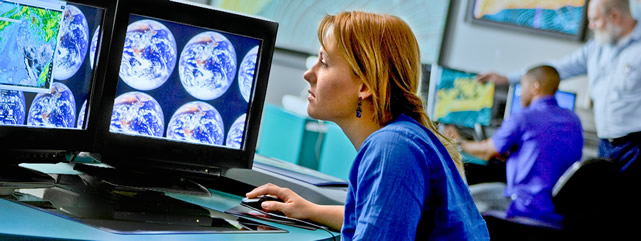Opportunities in the aviation industry extend far beyond a seat on the flight deck, and the Department of Applied Aviation Sciences at Embry-Riddle’s Prescott Campus offers the academic and practical knowledge to help you launch a rewarding career. Our degree programs feature small class sizes, leading-edge facilities and expert faculty to help chart your course to success.
What is Applied Science?
Applied science is employing the scientific method to reach conclusions, then using those conclusions to achieve practical goals. The Department of Applied Aviation Sciences offers programs that teach you how key scientific skills can open the door to aviation and aerospace careers.
Which career field is an Applied Science?
Earning an Applied Science degree from Embry-Riddle can help you toward a career in safety, management, training and operations, or as an air traffic controller, meteorologist or a career in the rapidly expanding field of unmanned aircraft systems.
Our experienced faculty members use state-of-the-art, computer-equipped classrooms and innovative, hands-on programs to give you the foundation you need for success.
Visit the website of the Department of Applied Aviation Sciences
Submissions from 2025
The Case of the Unexpected Attorney, Sarah Nilsson
The Future of Aviation: Becoming an eVTOL Pilot – FAA’s New Regulations Open Up Career Opportunities, Sarah Nilsson
Submissions from 2024
A Climatology of North American Monsoon Precipitation Over Arizona from MRMS Data, Greta Graeler, Mark Sinclair, and Curtis N. James
Surely You Can’t Be Serious: A Student’s Guide for Flight School Closure, Aidan McGlasson and Sarah Nilsson
Advanced Air Mobility (AAM) is Coming to a Town Near You...Are You Ready?, Sarah Nilsson
Advanced Air Mobility (AAM) is Coming to a Town Near You...Are You Ready?, Sarah Nilsson
The Future of Flying: An Exploration of New Aircraft Design and Energy Required to Support Advanced Air Mobility – Part 1, Sarah Nilsson
The Future of Flying: An Exploration of New Aircraft Design and Energy Required to Support Advanced Air Mobility – Part 2, Sarah Nilsson
The Future of Flying: An Exploration of New Aircraft Design and Energy Required to Support Advanced Air Mobility – Part 3, Sarah Nilsson
Women in Aviation – My Journey, Mentors, and Other Advice, Sarah Nilsson
Submissions from 2023
The Wings Program and the Compliance Program, Sarah Nilsson
Submissions from 2022
Girls in Aviation - Keynote Speaker, Sarah Nilsson
Submissions from 2019
Quality Analysis of United States Commercial Air Carriers: Airline Quality Rating 2019, Kaetlyn Blocker, Brent D. Bowen, Erin Bowen, Timothy B. Holt, and Dean E. Headley
Quality, Performance, and Consumer Perceptions: A National Study of US Airlines, Kaetlyn Blocker, Brent D. Bowen, Timothy B. Holt, Jacqueline R. Luedtke, Tori Kobayashi, Calissa Spooner, and Dean Headley
Submissions from 2017
Integrating Unmanned Aircraft Operations into the National Airspace System, Benjamin Cook, Holly Hughes, Allison Little, Kyle Wilkerson, Jennah C. Perry, Johnny Young, and Jacqueline Luedtke
Building a Collaborating Culture; A Need for Partnerships among K-12 and Postsecondary Institutions, Dr. Timothy B. Holt
General Aviation Hypoxia and Reporting Statistics, Timothy B. Holt, Jacqueline Luedtke, and Claire Schindler
The Utilization of Peer Mentorship and its Positive Impact on Student Retention, Timothy B. Holt, Jacqueline Luedtke, and Claire Schindler
The Vulnerabilities of Hypoxic Events Within General Aviation, Timothy B. Holt, Jacqueline Luedtke, and Claire Schindler
Undergraduate Research on General Aviation Hypoxia: A Student's Perspective, Timothy B. Holt, Jacqueline Luedtke, and Claire G. Schindler
Cirrus Cloud Microphysics over Darwin, Australia, Dorothea Ivanova and Matthew Johnson
Utilizing Guided Simulation in Conjunction with Digital Learning Tools in Air Traffic Control Training, Allison Little, Benjamin Cook, Holly Hughes, Kyle Wilkerson, Jacqueline Luedtke, and Jennah Perry
Modelling Fatigue for Management Decision Making: A Case Study, Rajee Olaganathan, Timothy B. Holt, and Jacqueline Luedtke
Adopting Unmanned Flight Operations into Controlled Airspace, Jennah C. Perry, Johnny Young, Jacqueline Luedtke, Benjamin Cook, Holly Hughes, Allison M. Little, and Kyle Wilkerson
Incorporating Digital Learning Tools in Conjunction with Air Traffic Control Simulation, Jennah Perry, Jacqueline Luedtke, Allison Little, Benjamin Cook, and Holly Hughes
Submissions from 2016
Leveraging the Dissemination of Scholarly Works, Brent D. Bowen, Jackie Luedtke, Timothy B. Holt, Mary M. Fink, and Hunter Watson
The Problem with Postsecondary Aviation Safety Training, as Voiced by Aviation Industry Professionals, Timothy B. Holt
Building Student Success and Retention through an Enhanced Peer Counseling Program, Timothy B. Holt, Jacqueline R. Luedtke, and Claire Schindler
Aircraft Cyber Security and Information Exchange Safety Analysis for Department of Commerce, Timothy B. Holt, Mohammad Moallemi, Linda Weiland, Matt Earnhardt, and Sonya McMullen
Submissions from 2014
The Microburst Wind Shear Phenomena: The pursuit and defeat of one of the greatest killers in aviation history, John McCarthy
Submissions from 2010
Will Very Light Jets Replace King Air Turboprops for Business Travel?, Vince Jean-Paul Pujalte
Submissions from 2005
Modification of Precipitation by Coastal Orography in Storms Crossing Northern California, Curtis N. James and Robert A. Houze Jr.
Submissions from 2004
Extratropical Transition of Southwest Pacific Tropical Cyclones. Part II: Midlatitude Circulation Characteristics, Mark R. Sinclair
Submissions from 2003
The Extratropical Transition of Tropical Cyclones: Forecast Challenges, Current Understanding, and Future Directions, Sarah C. Jones, Patrick A. Harr, Jim Abraham, Lance F. Bosart, Peter J. Bowyer, Jenni L. Evans, Deborah E. Hanley, Barry N. Hanstrum, Robert E. Hart, Francois Lalaurette, Mark R. Sinclair, Roger K. Smith, and Chris Thorncroft
Submissions from 2002
Extratropical Transition of Southwest Pacific Tropical Cyclones. Part I: Climatology and Mean Structure Changes, Mark R. Sinclair

